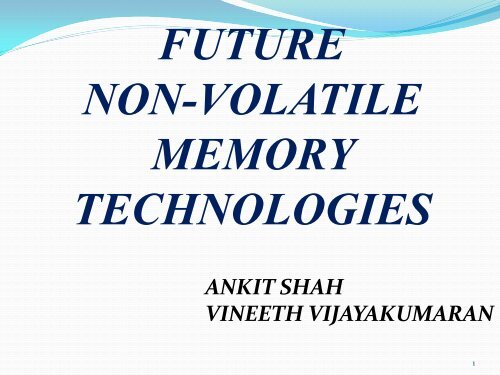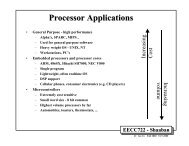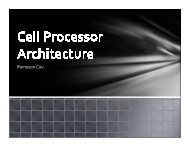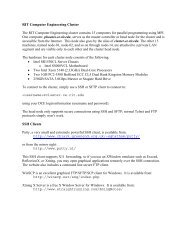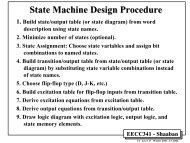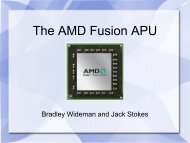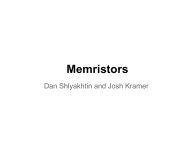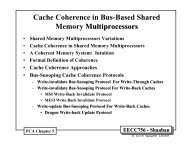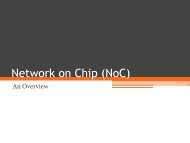FUTURE NON-VOLATILE MEMORY TECHNOLOGIES
FUTURE NON-VOLATILE MEMORY TECHNOLOGIES
FUTURE NON-VOLATILE MEMORY TECHNOLOGIES
You also want an ePaper? Increase the reach of your titles
YUMPU automatically turns print PDFs into web optimized ePapers that Google loves.
<strong>FUTURE</strong><br />
<strong>NON</strong>-<strong>VOLATILE</strong><br />
<strong>MEMORY</strong><br />
<strong>TECHNOLOGIES</strong><br />
ANKIT SHAH<br />
VINEETH VIJAYAKUMARAN<br />
1
Outline<br />
• Current Memory Technologies<br />
• Future Memory Technologies<br />
• What is MRAM ?<br />
• Working of MRAM<br />
• Advantages & Disadvantages - MRAM<br />
• What is Ferroelectric RAM (FeRAM or FRAM) ?<br />
• FeRAM -Superior Features<br />
• Compare FeRAM with EEPROM & FLASH<br />
• FeRAM –Memory cell , Write , Read , Application<br />
2
Current Memory Technologies<br />
‣ DRAMs<br />
• Volatile<br />
• Require standby power<br />
‣ Flash Memories<br />
• Limited write endurance<br />
• Low write speed<br />
‣ SRAMs<br />
• Volatile<br />
• Large cell size<br />
Combined revenues of these 3 memory<br />
technologies were ~26B$ in 2002<br />
3
Future Memory Technologies<br />
4
Magnetoresistive RAM<br />
(MRAM)<br />
5
What is MRAM ??<br />
• It is non-volatile memory.<br />
• Made up of millions of pairs of tiny ferromagnetic<br />
plates called as memory cells (Magnetic plates with<br />
very thin insulating material sandwiched between the<br />
plates).<br />
• Data is not stored as electric charge but by magnetic<br />
storage elements.<br />
6
Magnetoresistive Effect<br />
• Magnetic layer has a polarity – north pole and the<br />
south pole.<br />
• Their magnetic moments can have a parallel<br />
orientation or anti-parallel orientation.<br />
• Memory cell has low resistance when magnetic<br />
moments have parallel orientation and high resistance<br />
when magnetic moments have anti-parallel<br />
orientation.<br />
7
Continued<br />
• The magnetic moments and hence the resistance of<br />
the memory cell can be changed by application of<br />
magnetic field.<br />
• This effect is called as Magnetoresistive Effect.<br />
8
Working of MRAM<br />
• MRAM uses Magnetoresistive Effect.<br />
• Working of MRAM consists of mainly 2 parts<br />
i. Reading data from the memory cell.<br />
ii.<br />
Writing data to the memory cell.<br />
9
Read Operation<br />
• MRAM reads information<br />
by measuring the electric<br />
resistance of the specific<br />
cell.<br />
• Resistance is measured by<br />
passing a current through<br />
the memory cell.<br />
• It reads a ‘1’ if resistance is<br />
low and ‘0’ if resistance is<br />
high<br />
10
Write Operation<br />
• Current pulses are<br />
passed through the digit<br />
line and the bit line.<br />
• Currents generates a<br />
magnetic field that<br />
changes the orientation<br />
of the magnetic<br />
moments of particular<br />
memory cell.<br />
11
CONT‟D<br />
• Write takes place only on the bit in the array which is<br />
at cross point of the 2 lines.<br />
• The value stored depends on the resultant of the<br />
applied magnetic fields.<br />
• The “1” or “0” is stored by putting the free layer<br />
magnetic moment into the anti-parallel or parallel<br />
state.<br />
12
Advantages of MRAM<br />
• Non-volatile memory.<br />
• High speed read writes.<br />
• Unlimited Endurance.<br />
• Low power as compared to DRAM.<br />
• Magnetic polarization does not leak away with time<br />
like charge does.<br />
13
Disadvantages of MRAM<br />
• Cost ( $25 for 0.5 MB).<br />
• Limitation to reduction in cell size. Sense lines cannot<br />
get narrower than 1 micron.<br />
• Power required to write data is 3 to 8 times higher<br />
than power required to read data.<br />
14
Applications of MRAM<br />
• Current Application<br />
i. Cache buffers<br />
ii. Configurable Storage memories.<br />
• Potential Applications<br />
i. Cell phones, PDA’s, Notebooks.<br />
ii. Computing and Networking.<br />
iii. RFID<br />
iv. Military<br />
v. Cell phones and Mobile computing<br />
July 10 th 2006<br />
Freescale moved<br />
MRAM in volume<br />
production (4 MB<br />
product).<br />
15
FeRAM / FRAM<br />
16
Ferroelectric RAM (FeRAM or<br />
FRAM)<br />
• Random access memory similar in construction to DRAM<br />
• Uses a ferroelectric layer instead of a dielectric layer to<br />
achieve non-volatility<br />
• 320 patents granted by the U.S. patent office in last 3<br />
years. More than 120 ,during the past year alone.<br />
17
Superior Features<br />
• Short programming time<br />
• Lower power usage<br />
• Faster write performance<br />
FeRAM – A possible alternative for Flash<br />
18
Compare FeRAM with<br />
EEPROM & FLASH<br />
19
FeRAM- FerroElectric Materials<br />
Unique Characteristics<br />
• Upon the application of an electric field, there exists a Spontaneous<br />
electric polarization inherent to the crystal structure of the material<br />
• Furthermore, the polarization does not disappear even when the<br />
electric field is removed<br />
• Exhibits Hysteresis<br />
Example - Perovskites - PZT (PbO,ZrO2, TiO2) Lead-Zirconate-Titanate<br />
20
Electric Field on Ferroelectric<br />
Material<br />
•Applied External Electric Field moves the<br />
Center Atom in the direction of the field<br />
•Remain in that state even after the field is<br />
removed.<br />
•The position of the „central‟ atom affects the<br />
voltage which is used to determine whether it<br />
represents a 0 or a 1<br />
Electric Field<br />
Central Atom<br />
Stable States<br />
21
FeRAM - Ferroelectric capacitor<br />
• Ferroelectric capacitor?<br />
A regular capacitor substituted with a ferroelectric<br />
material instead of a dielectric<br />
• Hence provides non-volatility .<br />
Ferroelectric<br />
Material<br />
22
FeRAM – 1T-1C (one transistor, one<br />
capacitor) Memory cell<br />
• When the Access Transistor is ON, the Ferroelectric<br />
Capacitor(FE) is connected to the bitline(BL) and can be<br />
written to or read by the plateline (PL).<br />
• “CBL ” represents the total parasitic capacitance of the<br />
bitline.<br />
Access<br />
Transistor<br />
Ferroelectric<br />
Capacitor<br />
23
WRITE “1” OPERATION<br />
Timing Diagram<br />
State Sequence For the FE Capacitor<br />
24
WRITE “0” OPERATION<br />
Timing Diagram<br />
State Sequence For the FE Capacitor<br />
25
READ OPERATION<br />
(Destructive Read)<br />
•Precharge BL to 0 V<br />
•Activating WL establishes a capacitor<br />
divider between the PL and the ground is<br />
established<br />
•Depending on the data stored, FE<br />
capacitor can be approximated by C0 or C1<br />
and thus voltage could be V0 or V1<br />
•PL raised to VDD<br />
•At this point, the sense amplifier is<br />
activated to drive the BL<br />
If BL is V1 then full VDD<br />
If BL is V0 then full 0V<br />
•The WL is kept activated until the sensed<br />
voltage on the BL restores the original data<br />
back into the memory cell<br />
26
Salient Features –<br />
‣Low Write Access time<br />
‣Low power consumption<br />
Application - FeRAM<br />
Digital Camera –Fast frequent writes in order to store and restore<br />
images into the memory in less than 0.1 s.<br />
Contactless smart cards –Only use electromagnetic coupling to power up<br />
the electronic chips on the card.<br />
NOTE:<br />
FeRAM may play a major role in future 3G phones and personal digital<br />
systems .<br />
27
Conclusion<br />
28
References<br />
‣ MRAM<br />
“The future of things” website (http://thefutureofthings.com/articles/36/mram-the-birthof-the-super-memory.html)<br />
MRAM from wikipedia<br />
(http://en.wikipedia.org/wiki/Magnetoresistive_random_access_memory)<br />
‣ FeRAM<br />
A Survey of Circuit Innovations in Ferroelectric Random-Access Memories, Ali<br />
Sheikholeslami, MEMBER, IEEE, AND P. Glenn Gulak, SENIOR MEMBER,<br />
IEEE (http://www.eecg.utoronto.ca/~ali/papers/survey_proc.pdf)<br />
FeRAM from wikipedia (http://en.wikipedia.org/wiki/Ferroelectric_RAM)<br />
Presentation from Stefan Lai Co-Director, California Technology and<br />
Manufacturing February<br />
2003(http://www.ece.umd.edu/courses/enee759h.S2003/references/Stefan_Korea_0<br />
22703.pd)<br />
29
QUESTIONS?<br />
30


